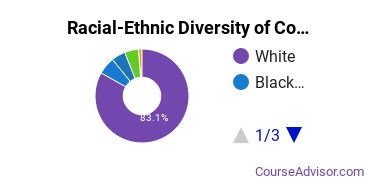Communication & Journalism at Murray State University
Murray State is located in Murray, Kentucky and approximately 9,449 students attend the school each year.
Want to know more about the career opportunities in this field? Check out the Careers in Communication & Journalism section at the bottom of this page.
Murray State Communication & Journalism Degrees Available
- Bachelor’s Degree in Communication & Journalism
- Master’s Degree in Communication & Journalism
Online Classes Are Available at Murray State
Don't have the time or the flexibility in your schedule to take traditional classes? Online courses may be the perfect solution for you. They allow independent learners to study when and where they want to while offering the rigor of in-person classes.
Murray State does offer online education options in communication & journalism for the following degree levels for those interested in distance learning:
- Master’s Degree
Murray State Communication & Journalism Rankings
The communication & journalism major at Murray State is not ranked on College Factual’s Best Colleges and Universities for Communication & Journalism. This could be for a number of reasons, such as not having enough data on the major or school to make an accurate assessment of its quality.
Find Murray State University Programs
With an online bachelor's degree in communication you'll have the opportunity to pursue a multitude of career options. From journalism and social media, to public relations, advertising and mass media, earning your BA in communication will allow you to strategize and communicate your ideas.
Effective communicators are always in demand, no matter the industry. The Master's in Communication degree from Southern New Hampshire University is a cutting-edge program designed for forward-thinking professionals.
BA in Communication - New Media
Explore the digital frontier as it relates to today's communications strategies with this specialized online bachelor's from Southern New Hampshire University.
Communication & Journalism Student Demographics at Murray State
Take a look at the following statistics related to the make-up of the communication & journalism majors at Murray State University.
Murray State Communication & Journalism Bachelor’s Program

About 80% of those who receive a bachelor's degree in communication & journalism at Murray State are white. This is above average for this degree on the nationwide level.
The following table and chart show the race/ethnicity for students who recently graduated from Murray State University with a bachelor's in communication & journalism.

| Race/Ethnicity | Number of Students |
|---|---|
| Asian | 0 |
| Black or African American | 3 |
| Hispanic or Latino | 1 |
| White | 49 |
| International Students | 2 |
| Other Races/Ethnicities | 6 |
Murray State Communication & Journalism Master’s Program

Of the students who received a communication & journalism master's degree from Murray State, 88% were white. This is above average for this degree on the natiowide level.
The following table and chart show the race/ethnicity for students who recently graduated from Murray State University with a master's in communication & journalism.

| Race/Ethnicity | Number of Students |
|---|---|
| Asian | 0 |
| Black or African American | 1 |
| Hispanic or Latino | 0 |
| White | 14 |
| International Students | 1 |
| Other Races/Ethnicities | 0 |
Concentrations Within Communication & Journalism
If you plan to be a communication & journalism major, you may want to focus your studies on one of the following concentrations. The completion numbers here include all graduates who receive any type of degree in this field from Murray State University. Some of these focus areas may not be available for your degree level.
| Concentration | Annual Degrees Awarded |
|---|---|
| Public Relations & Advertising | 86 |
| Communication & Media Studies | 12 |
| Radio, Television & Digital Communication | 8 |
| Journalism | 6 |
Related Majors
- Foreign Languages & Linguistics
- History
- Social Sciences
- English Language & Literature
- Liberal Arts / Sciences & Humanities
Related Programs
Learn about other programs related to Murray State University that might interest you.
BA in Communication - New Media
Explore the digital frontier as it relates to today's communications strategies with this specialized online bachelor's from Southern New Hampshire University.
BA in Communication - Public Relations
Prepare to develop your skills in building mutually beneficial relationships between organizations and their public audiences.
MA in Communication - New Media & Marketing
Keep your skills and knowledge at the forefront of new media technologies with this specialized online master's from Southern New Hampshire University.
Careers That Communication & Journalism Grads May Go Into
A degree in communication & journalism can lead to the following careers. Since job numbers and average salaries can vary by geographic location, we have only included the numbers for KY, the home state for Murray State University.
| Occupation | Jobs in KY | Average Salary in KY |
|---|---|---|
| Managers | 3,260 | $92,630 |
| Public Relations Specialists | 2,200 | $50,580 |
| Community Health Workers | 1,220 | $38,210 |
| Producers and Directors | 770 | $60,530 |
| Editors | 770 | $44,050 |
References
*The racial-ethnic minorities count is calculated by taking the total number of students and subtracting white students, international students, and students whose race/ethnicity was unknown. This number is then divided by the total number of students at the school to obtain the racial-ethnic minorities percentage.
More about our data sources and methodologies.

